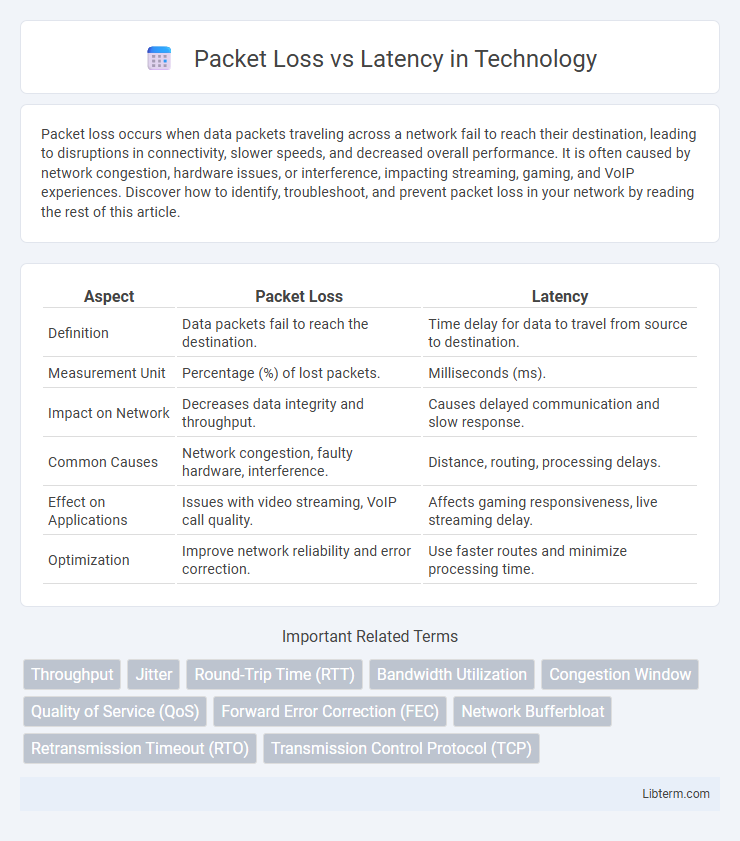Packet loss occurs when data packets traveling across a network fail to reach their destination, leading to disruptions in connectivity, slower speeds, and decreased overall performance. It is often caused by network congestion, hardware issues, or interference, impacting streaming, gaming, and VoIP experiences. Discover how to identify, troubleshoot, and prevent packet loss in your network by reading the rest of this article.
Table of Comparison
| Aspect | Packet Loss | Latency |
|---|---|---|
| Definition | Data packets fail to reach the destination. | Time delay for data to travel from source to destination. |
| Measurement Unit | Percentage (%) of lost packets. | Milliseconds (ms). |
| Impact on Network | Decreases data integrity and throughput. | Causes delayed communication and slow response. |
| Common Causes | Network congestion, faulty hardware, interference. | Distance, routing, processing delays. |
| Effect on Applications | Issues with video streaming, VoIP call quality. | Affects gaming responsiveness, live streaming delay. |
| Optimization | Improve network reliability and error correction. | Use faster routes and minimize processing time. |
Introduction to Packet Loss and Latency
Packet loss occurs when data packets traveling across a network fail to reach their destination, causing interruptions and degraded performance in applications like streaming and gaming. Latency refers to the time delay between sending and receiving data, impacting real-time communication and responsiveness in online activities. Both packet loss and latency critically affect network quality by reducing data transmission efficiency and user experience.
Defining Packet Loss: Causes and Effects
Packet loss occurs when data packets traveling across a network fail to reach their destination, often caused by network congestion, faulty hardware, or signal interference. This disruption leads to degraded performance, including slow load times, interrupted communication, and reduced application reliability. Understanding packet loss is crucial for optimizing network performance and minimizing latency-related issues in real-time services like VoIP and online gaming.
Understanding Network Latency
Network latency refers to the time it takes for data to travel from the source to the destination, significantly impacting real-time applications such as video conferencing and online gaming. High latency can cause noticeable delays, even if packet loss is minimal, undermining user experience by slowing responsiveness. Unlike packet loss, which involves dropped data packets that require retransmission, latency primarily concerns the speed and efficiency of data transmission across the network.
Key Differences Between Packet Loss and Latency
Packet loss refers to the failure of data packets reaching their destination, causing disruptions and decreased network reliability, while latency measures the delay in data transmission between source and destination, impacting responsiveness. Packet loss typically results from network congestion, faulty hardware, or signal degradation, whereas latency is influenced by distance, routing efficiency, and transmission mediums. Understanding these differences is crucial for optimizing network performance, as packet loss directly affects data integrity, and latency affects the speed of communication.
How Packet Loss Impacts Network Performance
Packet loss significantly degrades network performance by causing data retransmissions, which increases bandwidth consumption and delays. High packet loss results in reduced throughput and jitter, adversely affecting real-time applications such as VoIP and video conferencing. Network equipment and protocols like TCP experience decreased efficiency, leading to slower data transfer and compromised user experience.
Effects of Latency on User Experience
Latency directly impacts user experience by causing delays between input actions and system responses, resulting in noticeable lag during online gaming, video calls, and live streaming. High latency can lead to interruptions, reduced interactivity, and frustrating pauses, whereas packet loss primarily causes data corruption or missing information. Minimizing latency is critical for real-time applications, ensuring smooth communication and optimal performance for end-users.
Common Sources of Packet Loss and Latency
Common sources of packet loss include network congestion, faulty hardware, and unreliable wireless connections, which disrupt data transmission and degrade performance. Latency often arises from long physical distances between devices, inefficient routing protocols, and processing delays within network equipment that increase round-trip time. Both packet loss and latency significantly impact real-time applications such as VoIP, online gaming, and video streaming by causing delays and interruptions.
Monitoring and Measuring Packet Loss vs Latency
Monitoring packet loss and latency involves using network performance tools such as ping tests, traceroutes, and specialized software like Wireshark or SolarWinds to capture accurate data on data transmission quality. Packet loss is measured by calculating the percentage of lost packets out of total sent packets, while latency is quantified in milliseconds, indicating the delay in data travel time across a network. Continuous monitoring with SNMP or NetFlow protocols enables real-time detection of abnormal spikes in packet loss or latency, facilitating prompt troubleshooting and maintaining optimal network performance.
Optimizing Networks to Reduce Packet Loss and Latency
Optimizing networks to reduce packet loss and latency involves implementing Quality of Service (QoS) protocols that prioritize critical data traffic and minimize congestion. Utilizing advanced technologies such as traffic shaping, load balancing, and efficient routing algorithms ensures smoother data transmission and less retransmission. Network monitoring tools like SNMP and packet analyzers help identify bottlenecks and packet drops to proactively address performance issues.
Conclusion: Balancing Packet Loss and Latency in Modern Networks
Balancing packet loss and latency is crucial for optimizing modern network performance, as excessive packet loss disrupts data integrity while high latency degrades user experience. Effective network management involves deploying error correction protocols and low-latency routing technologies to minimize these issues. Prioritizing a trade-off between reducing packet loss and maintaining acceptable latency ensures reliable and responsive connectivity for critical applications like video streaming and online gaming.
Packet Loss Infographic

 libterm.com
libterm.com